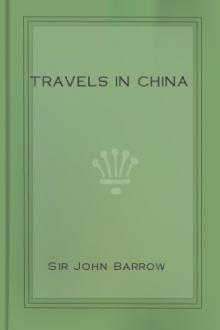Travels in China by Sir John Barrow (top e book reader .txt) 📕

[1] Monsieur (I beg his pardon) Citoyen Charpentier Cossigny.
Perhaps it may not be thought amiss, before he enters on the more immediate subject of the work, to correct, in this place, a very mistaken notion that prevailed on the return of the embassy, which was, that an unconditional compliance of Lord Macartney with all the humiliating ceremonies which the Chinese might have thought proper to exact from him, would have been productive of results more favourable to the views of the embassy. Assertions of such a general nature are more easily made than refuted, and indeed unworthy of attention; but a letter of a French missionary at Peki
Read free book «Travels in China by Sir John Barrow (top e book reader .txt) 📕» - read online or download for free at americanlibrarybooks.com
- Author: Sir John Barrow
- Performer: -
Read book online «Travels in China by Sir John Barrow (top e book reader .txt) 📕». Author - Sir John Barrow
A Foreign Trader.
Pub. May 2, 1804, by Messrs. Cadell, & Davies, Strand, London.
At the sight of our large ships, so different in their appearance from any of those belonging to the Chinese, a vast number of boats, issuing from every creek and cove, presently crowded together, in such a manner, and with so little management, as to render it difficult to pass through without danger of oversetting or sinking some of them; a danger, however, to which they seemed quite insensible. Vessels of a larger description, and various in the shape of their hulls and rigging, from twenty tons burden and upwards, to about two hundred tons, were observed in considerable numbers, sailing along the coast of the continent, laden generally with small timber, which was piled to such a height upon their decks, that no extraordinary force of wind would seem to be required to overturn them. Beams of wood, and other pieces that were too long to be received upon the deck of a single ship, were laid across the decks of two vessels lashed together. We saw at least a hundred couple thus laden in one fleet, keeping close in with the coast, in order to be ready, in case of bad weather, to put into the nearest port, being ill calculated to resist a storm at sea. The ships indeed that are destined for longer voyages appear, from their singular construction, to be very unfit to contend with the tempestuous seas of China. The general form of the hull, or body of the ship, above water, is that of the moon when about four days old. The bow, or forepart, is not rounded as in ships of Europe, but is a square flat surface, the same as the stern; without any projecting piece of wood, usually known by the name of cutwater, and without any keel. On each side of the bow a large circular eye is painted, in imitation, I suppose, of that of a fish. The two ends of the ship rise to a prodigious height above the deck. Some carry two, some three, and others four masts. Each of these consists of a single piece of wood, and consequently not capable of being occasionally reduced in length, as those of European ships. The diameter of the mainmast of one of the larger kind of Chinese vessels, such as trade to Batavia, is not less than that of an English man of war of sixty-four guns. And it is fixed in a bed of massive timber laid across the deck. On each mast is a single sail of matting, made from the fibres of the bamboo, and stretched by means of poles of that reed, running across, at the distance of about two feet from each other. These sails are frequently made to furl and unfurl like a fan. When well hoisted up and braced almost fore and aft, or parallel with the sides of the ship, a Chinese vessel will sail within three and a half, or four points of the wind; but they lose all this advantage over ships of Europe by their drifting to leeward, in consequence of the round and clumsy shape of the bottom, and their want of keel. The rudder is so placed, in a large opening of the stern, that it can occasionally be taken up, which is generally done on approaching sands and shallows.
The Chinese, in fact, are equally unskilled in naval architecture, as in the art of navigation. They keep no reckoning at sea, nor possess the least idea of drawing imaginary lines upon the surface of the globe, by the help of which the position of any particular spot may be assigned; in other words, they have no means whatsoever of ascertaining the latitude or the longitude of any place, either by estimation from the distance sailed, or by observation of the heavenly bodies, with instruments for that purpose. Yet they pretend to say, that many of their early navigators made long voyages, in which they were guided by charts of the route, sometimes drawn on paper, and sometimes on the convex surface of large gourds or pumpkins. From this circumstance, some of the Jesuits have inferred, that such charts must have been more correct than those on flat surfaces. If, indeed, the portion of the convex surface, employed for the purpose, was the segment of a sphere, and occupied a space having a comparative relation to that part of the surface of the earth sailed over, the inference might be allowable; but this would be to suppose a degree of knowledge to which, it does not appear, the Chinese had at any time attained, it being among them, in every period of their history, an universally received opinion, that the earth is a square, and that the kingdom of China is placed in the very center of its flat surface.
The present system of Chinese navigation is to keep as near the shore as possible; and never to lose sight of land, unless in voyages that absolutely require it; such as to Japan, Batavia, and Cochin-China. Knowing the bearing, or direction of the port intended to be made, let the wind be fair or foul, they endeavour, as nearly as possible, to keep the head of the ship always pointing towards the port by means of the compass. This instrument, as used in China, has every appearance of originality. The natives know nothing, from history or tradition, of its first introduction or discovery; and the use of the magnet, for indicating the poles of the earth, can be traced, from their records, to a period of time when the greatest part of Europe was in a state of barbarism. It has been conjectured, indeed, that the use of the magnetic needle, in Europe, was first brought from China by the famous traveller Marco Polo the Venetian. Its appearance immediately after his death, or, according to some, while he was yet living, but at all events, in his own country, renders such a conjecture extremely probable. The embassies in which he was employed by Kublai-Khan, and the long voyages he performed by sea, could scarcely have been practicable without the aid of the compass. Be this as it may, the Chinese were, without doubt, well acquainted with this instrument long before the thirteenth century. It is recorded in their best authenticated annals merely as a fact, and not as any extraordinary circumstance, that the Emperor Chung-ko presented an embassador of Cochin-China, who had lost his way in coming by sea, with a Ting-nan-tchin "a needle pointing out the south," the name which it still retains. Even this idea of the seat of magnetic influence, together with the construction of the compass-box, the division of the card into eight principal points, and each of these again subdivided into three, the manner of suspending the needle, and its diminutive size, seldom exceeding in length three quarters of an inch, are all of them strong presumptions of its being an original, and not a borrowed invention.
By some, indeed, it has been conjectured, that the Scythians, in the northern regions of Asia, were acquainted with the polarity of the magnet, in ages antecedent to all history, and that the virtue of this fossil was intended to be meant by the flying arrow, presented to Abaris by Apollo, about the time of the Trojan war, with the help of which he could transport himself wherever he pleased. The abundance of iron ores, and perhaps of native iron, in every part of Tartary, and the very early period of time in which the natives were acquainted with the process of smelting these ores, render the idea not improbable, of the northern nations of Europe, and Asia, (or the Scythians,) being first acquainted with the polarity of the magnet.
Yet even with the assistance of the compass, it is surprizing how the clumsy and ill-constructed vessels of the Chinese can perform so long and dangerous a voyage as that to Batavia. For, besides being thrown out of their course by every contrary wind, their whole construction, and particularly the vast height of their upper works above the water, seems little adapted to oppose those violent tempests that prevail on the China seas, known, as we have already observed, by the name of Ta-fung. These hurricanes sometimes blow with such strength that, according to the assertion of an experienced and intelligent commander of one of the East India Company's ships, "Were it possible to blow ten thousand trumpets, and beat as many drums, on the forecastle of an Indiaman, in the height of a Ta-fung, neither the sound of the one nor the other would be heard by a person on the quarter-deck of the same ship." In fact, vast numbers of Chinese vessels are lost in these heavy gales of wind; and ten or twelve thousand subjects from the port of Canton alone are reckoned to perish annually by shipwreck.
When a ship leaves this port on a foreign voyage, it is considered as an equal chance that she will never return; and when the event proves favourable, a general rejoicing takes place among the friends of all those who had embarked in the hazardous enterprize. Some of these ships are not less than a thousand tons burden, and contain half that number of souls, besides the passengers that leave their country, in the hope of making their fortunes in Batavia and Manilla. A ship is seldom the concern of one man. Sometimes forty or fifty, or even a hundred different merchants purchase a vessel, and divide her into as many compartments as there are partners, so that each knows his own particular place in the ship, which he is at liberty to fit up and to secure as he pleases. He ships his goods, and accompanies them in person, or sends his son, or a near relation, for it rarely happens that they will trust each other with property, where no family connexion exists. Each sleeping place is just the length and breadth of a man, and contains only a small mat, spread on the floor, and a pillow. Behind the compass is generally placed a small temple, with an altar, on which is continually kept burning a spiral taper composed of wax, tallow and sandal-wood dust. This holy flame answers a double purpose; for while the burning of it fulfils an act of piety, its twelve equal divisions serve to measure the twelve portions of time, which make up a complete day. It should seem that the superstitious notions inculcated in the people have led them to suppose, that some particular influence resides in the compass; for, on every appearance of a change in the weather, they burn incense before the





Comments (0)